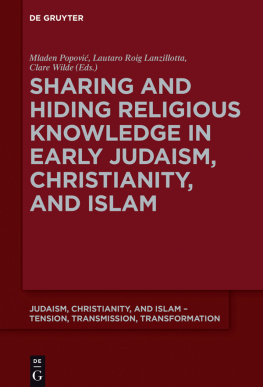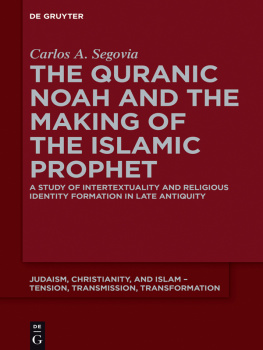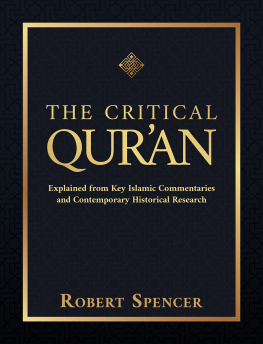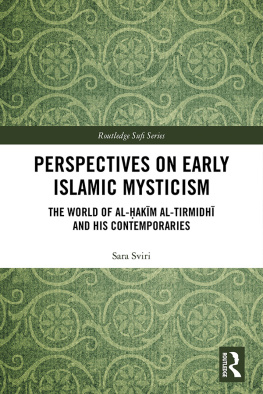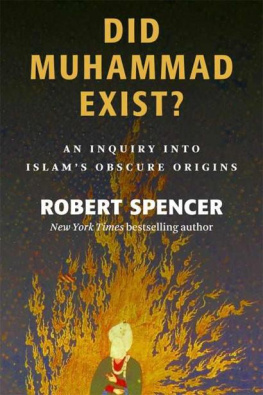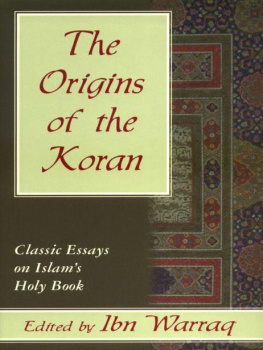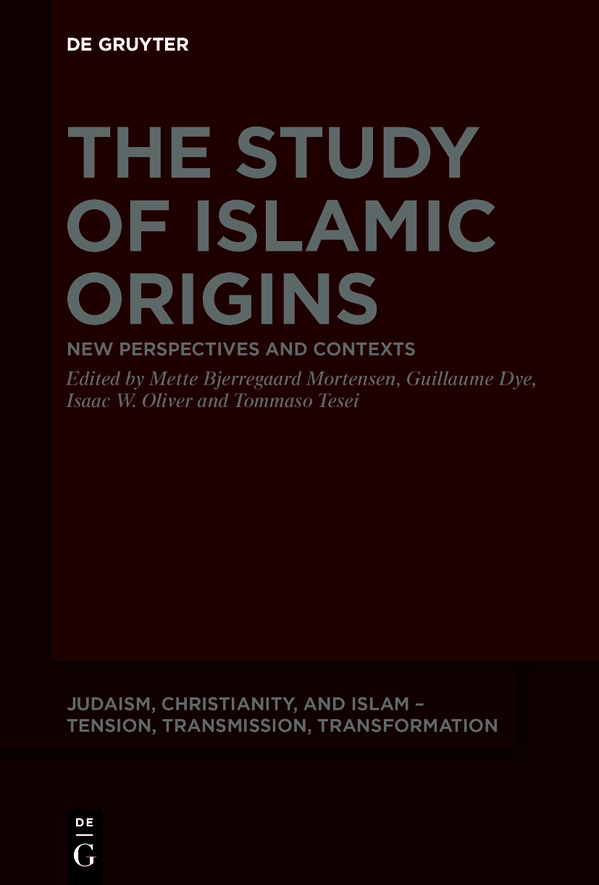Judaism, Christianity, and Islam Tension, Transmission, Transformation
Edited by
Patrice Brodeur
Alexandra Cuffel
Assaad Elias Kattan
Georges Tamer
Volume
ISBN 9783110675436
e-ISBN (PDF) 9783110675498
e-ISBN (EPUB) 9783110675566
Bibliographic information published by the Deutsche Nationalbibliothek
The Deutsche Nationalbibliothek lists this publication in the Deutsche Nationalbibliografie; detailed bibliographic data are available on the Internet at http://dnb.dnb.de.
2021 Walter de Gruyter GmbH, Berlin/Boston
Introduction
Mette Bjerregaard Mortensen
Universit libre de Bruxelles
Guillaume Dye
Universit libre de Bruxelles
Isaac W. Oliver
Bradley University
Tommaso Tesei
Duke Kunshan University
The following volume presents select proceedings from the second and third gatherings of the Early Islamic Studies Seminar (EISS). Both conferences took place in the beautiful Italian locations of Pratolino, near Florence, on June 1216, 2017 and Gazzada (at the Villa Cagnola), near Milan, on June 1620, 2019, respectively. They were hosted by the Enoch Seminar with the generous support of the Alessandro Nangeroni International Endowment.
The Enoch Seminar was founded by Gabriele Boccaccini in 2001 with the aim of gathering specialists of Second Temple Judaism from across the globe to share their research at conferences, which function more like small workshops, in which scholars intensively debate their ideas during several days in intimate settings that favor collegiality and dialogue. At its foundation, the Enoch Seminar sought and still seeks to recover both the integrity and the diversity of the intellectual traditions of the Second Temple period by breaking down the artificial and confessional barriers that have long divided its study. For too long the study of Second Temple Judaism(s) had been eclipsed by biblical studies, which naturally tends to prioritize the investigation of canonical literature. The Enoch Seminar offered ancient Jewish writings, movements, and traditions, which had hitherto been anachronistically sandwiched in between the Old Testament and the New Testament (and even the Mishnah), a central platform where they could be considered in their own right. Writings such as the sectarian documents discovered among the Dead Sea Scrolls or the so-called Old Testament Pseudepigrapha, received their due attention, shedding light on a period in which the Jewish Scriptures were still being composed.
Very soon, the Enoch Seminar incorporated the study of Christian origins within its scope of inquiry, since Christianity emerged from Second Temple Judaism and originally constituted but one of its many distinctive forms of expressions. This inclusion has coincided with recent trends in the scholarly investigation of Judaism and Christianity in antiquity, which sees tremendous heuristic value in studying the diverse traditions of these two entities in light of one another. Once upon a time, ancient Christianity was merely studied against a Jewish background (and consequently its Jewish character remained relegated to the back), while the New Testament was neglected as an important source for understanding Second Temple Judaism. The reigning assumption posited that Judaism and Christianity inevitably morphed into separate, discrete entities early on, that Jewish-Christian relations in antiquity were marked solely by antagonism and division. Studies on the New Testament/early Christianity and Second Temple Judaism were carried out in isolation from one another, with each field represented by its own academic programs, conferences, journals, specialists, jargon, and so on.
In recent decades, however, new intellectual paradigms have radically altered the historical understanding of Christian and rabbinic origins and redefined the disciplinary landscape that had hitherto reified the boundaries between Jews and Christians in antiquity. While admitting that relations between (some) Jews and (some) Christians were certainly marked by confrontation early on, many scholars now firmly situate primitive Christianity within its original Jewish environment while avoiding teleological views that reduce the complexity and diversity of early Jewish-Christian relations to inevitable fracturing and opposition. It is now more readily acknowledged that Jewish and Christian identities remained fluid, diverse, and in the making throughout Late Antiquity, with patristic and rabbinic orthodoxies proving formative rather than normative during this period. These newer perspectives have in turn necessitated greater collaboration between specialists from different fields, which the Enoch Seminar has readily been able to foster.
In more recent times, the Enoch Seminar has expanded its purview even further to encompass the study of Islamic origins. The genesis of this endeavor began in June 2013 in Brussels, during a meeting between Guillaume Dye and Carlos A. Segovia, who were soon joined by Emilio Gonzlez Ferrn, Manfred Kropp, and Tommaso Tesei as board of directors to create the Early Islamic Studies Seminar (EISS). With the support of the Enoch Seminar, the EISS has since then organized three Nangeroni Meetings devoted to the Qurn and early Islam, convinced that the historical investigation of early Islam should be performed in a similar way as early Judaism and Christianity. In the inclusive spirit promoted by the Enoch Seminar, the EISS has accordingly invited to its meetings specialists in Quranic and Islamic studies as well as those who specialize in the Hebrew Bible, Second Temple Judaism, the New Testament, and other related fields. Indeed, the time seems ripe to appreciate the formation of the Qurn and early Islam in light of Jewish, Christian, and other late antique traditions (Zoroastrian, Manichean, etc.). Perhaps, this type of inquiry will yield new unexpected results about the origins of Islam that will in turn enrich our understanding of the rich religious landscape of Late Antiquity. With the publication of this volume, we hope to offer promising glimpses into this kind of undertaking.
The first part of this volume begins with two essays that address theoretical and methodological issues concerning the study of early Islam. In The Current Status and Problems of Islamic Origins: The View from the Academic Study of Religion, Aaron W. Hughes reflects on the current state of the study of Islamic origins. For Hughes, the study of Islamic origins entails a study of Jewish and Christian origins as well, since the Arabian Peninsula and Eastern regions of the burgeoning early Islamic Empire rose from and shaped a socially porous world that extended from the period of Late Antiquity. Islam, in other words, did not merely emerge from previously established monotheisms in the area but played an active role in their self-definition. Yet institutional, epistemological, and political issues beset this kind of historical enterprise, and it is to these problems that Hughes turns with the hope of showing how the academic study of religion can promisingly illuminate Islamic origins. Throughout, Hughes argues that the academic study of Islamic origins should be reframed as a late antique problem in which Islamic origins learns from and contributes to antique and late antique social formations.
An example of such a late antique framing of the question of the origins of Islam can be found in Stephen Shoemakers contribution to the volume where he emphasizes the importance of genre by comparing the Quran to its late antique predecessors. This question has long vexed scholars of the Qurn who have struggled to find a suitable category for what


